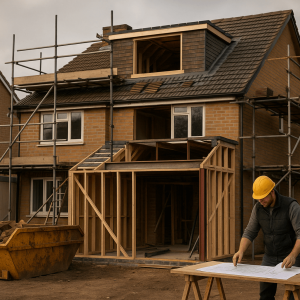“My build estimate” should show scope tied to drawings, measured quantities with unit rates, prelims, OHP, risk/contingency, inflation and VAT—so quotes are comparable.
If you’ve just received my build estimate from a builder or estimator and you’re not sure what it really covers, this guide breaks it down line-by-line. You’ll learn what each section means, how to spot red flags, and how to turn my build estimate into a quote you can trust. For deeper context, see Estimating vs Quoting – What’s the Difference?, our RICS NRM guide, and the UK Building Cost Estimator.
Executive Answer
A dependable version of my build estimate should clearly state scope and drawings, show measured quantities with unit rates, include preliminaries, overhead & profit, risk/contingency, inflation, and the VAT position structured to RICS NRM so you can compare quotes fairly. Region: UK (Great Britain). Base date: Q4 2025. VAT stance: Prices in this article exclude VAT unless stated. Units: m², m, l/m, m³, mm. Currency: GBP.
Table of Contents
- What “My Build Estimate” Actually Is
- “My Build Estimate” Checklist (What Good Looks Like)
- Decode “My Build Estimate” Line by Line
- Prime Cost (PC) vs Provisional Sums (PS)
- Preliminaries (Site Costs) Explained
- Overheads & Profit (OHP) Explained
- VAT: When It’s 20% and When It Isn’t
- Red Flags in “My Build Estimate” (and Fixes)
- How to Compare Two Estimates Fairly
- How to Improve “My Build Estimate” Before Tender
- Programme and Turnarounds
- Key Facts & Assumptions (At a Glance)
- FAQs
- Sources
What “My Build Estimate” Actually Is
An estimate is a professional calculation of likely costs based on your drawings, specification and site information. It isn’t a fixed price contract until scope and terms are locked. A strong “my build estimate” uses a recognised structure (e.g., RICS NRM), sets out assumptions/exclusions, and includes allowances for prelims, risk and inflation so you can make informed decisions.
“My Build Estimate” Checklist (What Good Looks Like)
- Scope + drawing revisions: exactly what was priced (drawing numbers/dates/revisions).
- Measurement rules: NRM1/NRM2 or a clear trade breakdown.
- Quantities × unit rates: m², m, l/m, m³ with waste/overlaps shown where relevant.
- Materials & spec: brand/series or performance level (e.g., U-values, finish grade).
- Preliminaries: welfare, supervision, access/scaffolds, logistics, testing/commissioning.
- OHP: overhead & profit shown separately from cost of works.
- Risk/contingency: proportionate to design stage (see ranges below).
- Inflation: allowance from base date to mid-point of construction.
- VAT: rate and evidence where a relief is claimed.
- Assumptions/exclusions: one-page log with any provisional sums.
Decode “My Build Estimate” Line by Line
Use this table to understand common lines and what to query before you proceed.
| Line on “My Build Estimate” | What It Means | What to Check | Typical Pitfalls |
|---|---|---|---|
| Scope summary & drawings revision | Which plans/specs were priced | Drawing numbers, dates, revision letters | Out-of-date drawings cause re-pricing later |
| Measurement basis (NRM1/NRM2) | How quantities were structured/measured | Ask for NRM alignment or clear trade breakdown | Inconsistent structure makes comparisons unfair |
| Quantities & unit rates | Measured amounts × priced rates | Units (m², m, l/m, m³), waste factors, laps | Missing overlaps/waste (roofing, membranes) |
| Materials (brand/spec) | Products and performance levels | Brand/series, U-values, finish grade | “Or equal” vagueness; quality swaps later |
| Labour & productivity | Trade hours assumed to install | Day rates, hours per unit, supervision | Unrealistic productivity creates shortfalls |
| Plant & access | Scaffold, access towers, machinery | Durations, heights, loading/access limits | Missed scaffold lifts or extra hires |
| Preliminaries | Site setup, welfare, management, logistics | Welfare size, skips/muck-away, traffic plans | Lumped “prelims” with no detail |
| Overheads & Profit (OHP) | Business overhead recovery and margin | Shown separately from cost of works | Hidden in rates, hard to compare |
| Risk/contingency | Allowance for unknowns at this stage | % level vs RIBA stage (see below) | 0% contingency at early design stages |
| Inflation | Uplift from base date to project mid-point | Index/assumption and period covered | None stated → later “price rise” disputes |
| VAT | Tax treatment of the works | 20% standard vs any relief (evidence!) | Incorrect 0% claim without eligibility |
| Assumptions/exclusions | What’s included/left out; PS items | Clarity + ownership of risks | Missing list → scope creep later |
Prime Cost (PC) vs Provisional Sums (PS)
PC (Prime Cost): an allowance for a supply item (e.g., sanitaryware) excluding installation. You choose the actual product; total changes with your selection.
PS (Provisional Sum): an allowance for work that can’t be fully defined yet (e.g., drainage repair). Replace PS with firm quantities/prices as soon as info is available.
Preliminaries (Site Costs) Explained
Prelims cover the cost of running the site: welfare, supervision, access, scaffolds and logistics. Good prelims in my build estimate are built from the method (not a guess) and show durations or quantities so you can test them.
Overheads & Profit (OHP) Explained
OHP is the contractor’s overhead recovery plus a margin for risk and return. Asking for OHP to be shown separately from the direct cost of works makes comparisons fairer and reduces disputes later.
VAT: When It’s 20% and When It Isn’t
Most building work is standard-rated at 20%. Some residential projects qualify for zero or reduced rates (e.g., new dwellings; certain energy-saving measures). If your “my build estimate” shows a relief, ask for the basis and keep evidence with your records.
Red Flags in “My Build Estimate” (and Fixes)
- One-line “prelims”: ask for a breakdown (welfare, supervision, scaffolds, skips, logistics).
- Missing revisions: ensure drawing numbers/dates are stated or get the estimate re-issued.
- Too many PS items: convert to firm quantities ASAP; otherwise you carry price risk.
- Unstated VAT/inflation: request both in writing with assumptions and dates.
- “Or equal” specs: define products/performance or agree acceptable ranges.
How to Compare Two Estimates Fairly
- Make both parties price the same drawings/spec with a clear revision date.
- Use an NRM-structured breakdown (elements or trades) so line-items match.
- Lay estimates side-by-side; highlight differences in prelims, risk, and PS.
- Normalize the VAT and inflation assumptions before judging totals.
Need help turning my build estimate into a like-for-like tender pack? Request a Custom Estimate and we’ll structure it for you.
How to Improve “My Build Estimate” Before Tender
- Freeze drawings and issue a one-page assumptions/exclusions log.
- Specify performance levels (e.g., U-values, fire rating) where brands aren’t fixed.
- Get two supplier quotes for major items and record validity dates.
- Set contingency by stage: 10–15% at RIBA 2–3; 5–10% at RIBA 4–5.
- Apply inflation from base date to mid-point of construction and state the index.
Programme and Turnarounds
- Review/normalise “my build estimate”: typically 2–4 working days depending on completeness.
- Independent estimate (small domestic): often 3–7 working days from complete information (24-hour option may be available for simple scopes—ask via Quick Quote).
Key Facts & Assumptions (At a Glance)
- Keyword focus: “my build estimate” (primary), plus “builder’s estimate”, “construction estimate UK”.
- Region & base date: Great Britain; Q4 2025; VAT excluded unless stated.
- Standards: RICS NRM1 (elemental) and NRM2 (BOQ) for structure and measurement.
- Contingency: 10–15% at RIBA 2–3; 5–10% at RIBA 4–5 as designs fix.
- Inflation: from base date to project mid-point; state the assumption you use.
- Units & currency: m², m, l/m, m³, mm; GBP.
FAQs
Is “my build estimate” the final price?
No. It’s a professional forecast based on current information. It becomes a fixed price only when agreed as a quote/contract on a frozen scope.
What if “my build estimate” has lots of provisional sums?
That means parts of the scope aren’t fully defined. Push to replace PS with measured quantities and firm prices before you commit.
Should preliminaries be shown separately?
Yes. Clear prelims (welfare, supervision, access, logistics) make comparisons fair and reduce disputes.
How much contingency should I set?
As a planning rule: 10–15% at early stages (RIBA 2–3) and 5–10% once designs are fixed (RIBA 4–5).
Why does VAT change between builders?
Some projects qualify for reliefs (e.g., new dwellings, specific energy-saving measures). Ask for the basis and keep evidence.











